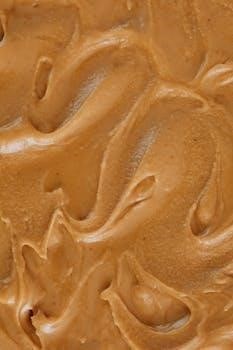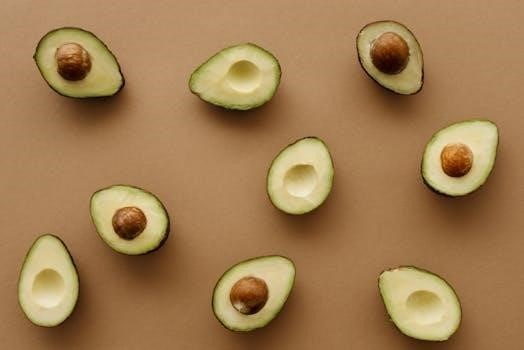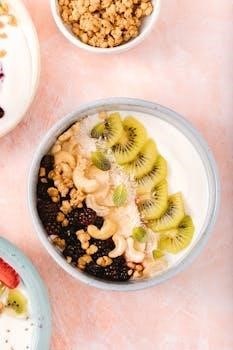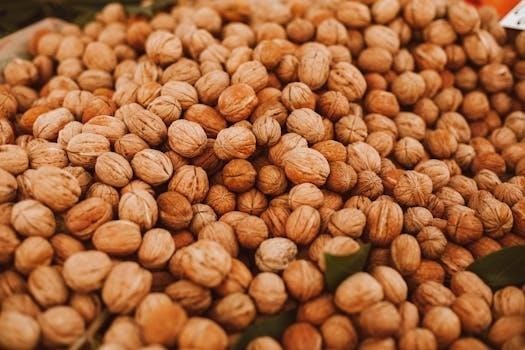Exploring a low-fat diet involves understanding how to select foods with minimal fat content‚ which can aid in weight management and promote heart health․ This approach focuses on choosing naturally low-fat options and reducing consumption of high-fat items․ It’s about making informed dietary choices that align with your health goals․
Understanding the Benefits of a Low-Fat Diet
A low-fat diet offers several potential health advantages‚ particularly in the realm of cardiovascular well-being and weight management․ By reducing the intake of fats‚ especially saturated fats‚ individuals can lower their cholesterol levels‚ thus decreasing the risk of heart disease․ This dietary approach can also aid in weight loss by limiting calorie-dense foods‚ as fats are high in calories․ Furthermore‚ incorporating more fruits‚ vegetables‚ and lean proteins‚ which are naturally low in fat‚ enhances overall nutrition․ This diet can also help in reducing inflammation in the body․ A balanced low-fat diet‚ coupled with regular exercise‚ can contribute significantly to a healthier lifestyle․ This eating pattern encourages mindful food choices‚ promoting long-term wellness by selecting nutrient rich options over high fat ones․ It also supports the maintenance of a healthy metabolism and protects muscle mass during weight loss․

Identifying Low-Fat Food Categories
Navigating a low-fat diet involves recognizing key food groups that naturally contain less fat․ These categories include an abundance of fruits and vegetables‚ lean proteins‚ and specific low-fat dairy options‚ forming the basis of this dietary approach․
Naturally Low-Fat Options⁚ Fruits and Vegetables
Fruits and vegetables are cornerstones of a low-fat diet‚ offering a wealth of nutrients with minimal fat content․ These plant-based foods are naturally low in fat‚ with exceptions like avocados and coconuts‚ making them ideal for those seeking to reduce their fat intake․ Leafy greens like spinach‚ vibrant in color and rich in nutrients‚ exemplify this category․ Most fruits‚ from berries to apples‚ are incredibly low in fat‚ and provide essential vitamins‚ minerals‚ and fiber․ This makes them a great choice for snacks and meals․ Vegetables‚ in their diverse forms‚ whether cooked or raw‚ are foundational for any low-fat meal plan․ Incorporating a variety of colors and types ensures a broad spectrum of nutrients and antioxidants․ The natural composition of fruits and vegetables allows for versatile meal preparations‚ supporting both weight management and overall well-being as a fundamental part of a healthy diet‚ ensuring you get your daily dose of goodness with minimal fat․
Lean Proteins⁚ Essential for Low-Fat Eating
Lean proteins are crucial for a low-fat diet‚ providing essential amino acids without excessive fat․ These sources are vital for muscle maintenance‚ satiety‚ and overall health․ Opting for lean cuts of meat‚ poultry‚ and fish helps to minimize saturated fat intake‚ which is important for heart health․ Examples include skinless chicken and turkey‚ as well as fish like cod and tuna․ Incorporating plant-based proteins such as legumes‚ lentils‚ and tofu‚ also offers a low-fat alternative‚ rich in fiber and other nutrients․ These options support a balanced low-fat diet‚ ensuring that the body receives the necessary protein for various functions․ Choosing the right protein sources is crucial‚ as it allows for muscle building and repair without the added unhealthy fats․ Including a variety of lean protein options in your diet is key to maintaining good health and achieving the goals of a low-fat eating plan‚ keeping you full and energized․
Low-Fat Dairy and Alternatives
Low-fat dairy and its alternatives are vital components of a low-fat diet‚ offering essential nutrients like calcium and vitamin D with reduced fat content․ Opting for low-fat milk‚ yogurt‚ and cheese helps minimize saturated fat intake‚ beneficial for cardiovascular health․ For those who are lactose intolerant or prefer plant-based options‚ alternatives such as almond‚ soy‚ or oat milk provide similar nutritional benefits with minimal fat․ These non-dairy alternatives often come fortified with calcium and vitamins‚ making them excellent substitutes․ Selecting low-fat or fat-free dairy products or plant-based options is essential for keeping saturated fat consumption low and supporting overall health․ These choices help maintain a balanced diet while fulfilling nutritional needs without excessive fat․ Incorporating a variety of these options will not only make your diet more interesting but also ensure you get the needed nutrients for good health․ The right dairy and alternatives can significantly contribute to the success of a low-fat eating plan․

Navigating Food Labels for Low-Fat Choices
Understanding food labels is crucial for making informed low-fat choices‚ allowing you to identify products that are lower in fat and saturated fat․ This skill helps in selecting healthier options while grocery shopping․
Understanding Fat Content on Labels
Deciphering fat content on food labels is essential for anyone following a low-fat diet․ Pay close attention to the “Total Fat” section‚ which indicates the total grams of fat in a serving․ However‚ it’s crucial to look beyond total fat and examine the types of fats listed‚ especially saturated and trans fats‚ which should be limited․ Saturated fats can raise cholesterol levels‚ increasing the risk of heart disease‚ while trans fats are considered even more harmful․ The “Percent Daily Value” (%DV) can help you understand how much of your daily recommended fat intake a serving provides․ Aim for foods with a lower %DV for total fat‚ particularly saturated and trans fats․ Look for labels that clearly state “low fat” or “fat-free”‚ but always verify these claims by checking the nutrition information․ Remember that even products labeled “reduced fat” may still contain a significant amount of fat‚ so comparing labels among similar products is crucial to make better choices in line with a low-fat diet․

Creating a Low-Fat Meal Plan
Developing a low-fat meal plan involves carefully selecting foods from various categories‚ including fruits‚ vegetables‚ lean proteins‚ and low-fat dairy․ The goal is to create balanced meals that are both satisfying and nutritious‚ while being low in fat․
Sample Low-Fat Meal Ideas
For breakfast‚ consider a bowl of oatmeal made with low-fat milk or a plant-based alternative‚ topped with fresh berries and a sprinkle of nuts․ Another option is a veggie-packed omelet using egg whites and plenty of spinach‚ tomatoes‚ and bell peppers․ Lunch could feature a vibrant salad with grilled chicken breast or chickpeas‚ mixed greens‚ and a light vinaigrette dressing․ Alternatively‚ a turkey breast sandwich on whole-grain bread with mustard and lots of vegetables makes a satisfying choice․ Dinner might include baked fish or lean chicken with steamed or roasted vegetables‚ such as broccoli‚ carrots‚ and sweet potatoes․ Another hearty option is a lentil soup with a side of whole-grain bread․ Snacks can include fresh fruits‚ low-fat yogurt‚ or a small handful of almonds․ It is important to choose foods that keep you full and satisfied‚ without relying on high-fat options․ These meal ideas are designed to be balanced‚ nutritious‚ and low in fat‚ supporting your overall health and wellness․ Remember to adjust portion sizes to meet your individual needs․

Foods to Limit or Avoid on a Low-Fat Diet
To effectively follow a low-fat diet‚ it’s crucial to reduce or eliminate foods high in saturated and trans fats‚ such as red meat‚ fried foods‚ and many processed snacks and baked goods․
Saturated Fats and Their Impact
Saturated fats‚ commonly found in animal products and some plant-based oils‚ can significantly impact your health‚ particularly when consumed in excess on a low-fat diet․ These fats are known to elevate levels of LDL cholesterol‚ often referred to as “bad” cholesterol‚ which increases the risk of developing heart disease․ High saturated fat intake can also contribute to weight gain and other metabolic health issues‚ counteracting the goals of a low-fat dietary approach․ It’s important to be mindful of the sources of saturated fats in your diet‚ such as fatty meats‚ full-fat dairy products‚ and certain processed foods‚ and to choose lower-fat alternatives․ Reducing saturated fat intake is a key element of a healthy‚ low-fat eating plan․ This helps in maintaining a healthy weight and reducing the risk of cardiovascular problems‚ making it a critical consideration when adopting a low-fat lifestyle․ By understanding the effects of saturated fats‚ you can make better choices to support your overall health and well-being․
